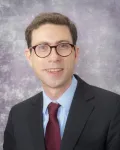(Press-News.org) An HPR abstract sessions at the 2024 EULAR congress looked specifically at harnessing the benefits of exercise in rheumatic and musculoskeletal diseases (RMD) – and the challenges to their practical implementation.
Mohamed Saadi presented a systematic review examining barriers and facilitators affecting adherence to EULAR’s physical activity recommendations. Across 68 selected articles, 29 different themes were identified – 9 of which were social, 16 environmental, and 4 systemic. The five most frequently found themes were having supportive family and friends, a supportive health professional, followed by costs, and access or proximity to adapted and supervised programs.
Importantly, there may be country-level differences in these three key factors. Social considerations include the level of support available, as well as whether people feel social pressure or body shaming, and if they have social physical activity built into their everyday lives – such as walking a dog or playing with children. Systemic differences may be apparent in costs and financial support. Environmental factors take into account aspects such as the weather, safety – and the transport needed to get to a place for physical activity. These each influence the adoption of the recommendations at an individual level. Further research is needed to understand these differences and tailor strategies for each country. As the next phase of the project, the researchers intend to develop a questionnaire to be used in four European countries. This will further identify barriers and facilitators for the uptake and adherence to physical activity according to EULAR recommendations on physical activity.
Similar qualitative work is already underway elsewhere, with information on facilitators and barriers being collected across four rheumatology outpatient clinics in Denmark. This included 10 days of observations in clinical practice – looking at patients’ routine consultations with physicians and nurses. Additionally, 12 individual, semi-structured interviews were performed with physicians, nurses, and clinical leaders. Tanja Thomsen – the first author and presenter of the work at the EULAR congress – personally conducted all observations and interviews. The Theoretical Domains Framework – with psychological and organisational domains relevant to clinical behaviour change – and a template analysis was used in the data work-up and interpretation.7,8
Barriers described by nurses and physicians were especially related to the domains of skills, competencies, and professional role or identity. This underscores the need for targeted training among healthcare professionals to allow them to provide sufficient guidance on physical activity. It also highlighted their perception of responsibility in discussing physical activity with patients. A primary barrier described by clinical management, was related to environmental context and resources – essentially around a potential lack of physical and clinical resources to provide the appropriate guidance. A mutual facilitator among informants was related to optimism, revealing shared beliefs about the possibility and potential of physical activity guidance as part of rheumatology routine care.
Taken together, these two pieces of work provide valuable knowledge about factors to address in the implementation of physical activity guidance for people with an RMD.
Source
Davergne T, et al. Systematic review on barriers and facilitators for people with rheumatic and musculoskeletal diseases for adherence to EULAR physical activity recommendations. Presented at EULAR 2024; OP0159-HPR.
Ann Rheum Dis 2024; DOI: 10.1136/annrheumdis-2024-eular.5816.
Thomsen T, et al. Implementation of Physical Activity Guidance in Rheumatology Practice – What are the Barriers and Facilitators? A Qualitative Study. Presented at EULAR 2024; OP0164-HPR.
Ann Rheum Dis 2024; DOI: 10.1136/annrheumdis-2024-eular.1948.
References
1. Rausch Osthoff A-K, et al. 2018 EULAR recommendations for physical activity in people with inflammatory arthritis and osteoarthritis. Ann Rheum Dis 2018;77(9):1251–60.
2. Fabre S, et al. Physical activity in patients with axial spondyloarthritis: a cross-sectional study of 203 patients. Rheumatol Int 2016;36(12):1711–8.
3. Metsios GS, et al. Implementation of Physical Activity into routine Clinical pracTice in Rheumatic Musculoskeletal Disease: The IMPACT-RMD study protocol and rationale. Mediterr J Rheumatol 2019;30(4):231–6.
4. Rausch Osthoff A-K, et al. Effects of exercise and physical activity promotion: meta-analysis informing the 2018 EULAR recommendations for physical activity in people with rheumatoid arthritis, spondyloarthritis and hip/knee osteoarthritis. RMD Open 2018;4(2):e000713.
5. Hu H, et al. The effect of physical exercise on rheumatoid arthritis: An overview of systematic reviews and meta-analysis. J Adv Nurs 2021;77(2):506–22.
6. Sveaas S, et al. Effect of cardiorespiratory and strength exercises on disease activity in patients with inflammatory rheumatic diseases: a systematic review and meta-analysis. Br J Sports Med 2017;51(14):1065–72.
7. Atkins L, et al. A guide to using the Theoretical Domains Framework of behaviour change to investigate implementation problems. Implement Sci 2017;12(1):77.
8. Brooks J, et al. The Utility of Template Analysis in Qualitative Psychology Research. Qual Res Psychol 2015;12(2):202–22.
About EULAR
EULAR is the European umbrella organisation representing scientific societies, health professional associations and organisations for people with rheumatic and musculoskeletal diseases (RMDs). EULAR aims to reduce the impact of RMDs on individuals and society, as well as improve RMD treatments, prevention, and rehabilitation. To this end, EULAR fosters excellence in rheumatology education and research, promotes the translation of research advances into daily care, and advocates for the recognition of the needs of those living with RMDs by EU institutions.
Contact
EULAR Communications, communications@eular.org
Notes to Editors
EULAR Recommendations
EULAR School of Rheumatology
EULAR Press Releases
END
Implementing physical activity recommendations
Identifying key barriers and facilitators
2024-06-13
ELSE PRESS RELEASES FROM THIS DATE:
Achieving drug-free remission in AXSPA
2024-06-13
Even though early therapeutic interventions have proven successful in inducing drug-free remission in other inflammatory rheumatic diseases, such studies remain difficult to conduct in axial spondyloarthritis (axSpA), which manifests itself by insidious onset inflammatory back pain. As a result it is often diagnosed late,5 and a consensus definition of early disease was only recently published.6
At the 2024 EULAR congress, Łukasik and colleagues shared data from their prospective study evaluating the efficacy of a ...
Unpicking the pathogenesis of RA
2024-06-13
Rheumatoid arthritis (RA) is an autoimmune disease that causes joint inflammation and destruction.1 There is currently no cure – and although there are many treatments, their effectiveness varies from person to person, suggesting an undefined pathogenic diversity.1 Deep characterisation of myeloid cell subsets by single cell RNA sequencing across healthy and inflamed tissues in RA has led to the identification of new pathogenic cell states and subsets – with data coming from five large-scale studies.1-5 But subset overlap across studies and compartments – such as in blood versus synovial tissue – has not yet ...
Kids First DRC launches enhanced data portal to strengthen collaborative pediatric research
2024-06-13
The Gabriella Miller Kids First Data Resource Center (Kids First DRC) announces the release of an upgraded Kids First Data Resource Portal, designed to streamline big data search and data analysis. Accessible at portal.kidsfirstdrc.org, the new portal represents a significant advancement in data accessibility, user experience, and collaborative potential with researchers, families, and patients.
Elevated User Experience
Introducing several key enhancements, the new Kids First DRC Portal prioritizes user-centric ...
Neural balance in the brain is associated with brain maturity and better cognitive ability
2024-06-13
In a world where external and internal stimuli can throw our entire body system off balance, how does our brain prevent itself from becoming overly stimulated?
The answer lies in our brain’s ability to maintain the balance of neural excitation (E) and inhibition (I), known as the E/I ratio. By regulating the E/I ratio, the brain prevents over-stimulation and under-stimulation.
The E/I ratio of children decreases with healthy development. Children with a lower E/I ratio were observed to have better performance than their peers in cognitive tests such as memory and intelligence, according to studies by researchers from the Centre for Sleep and Cognition ...
Parliamentary members use simpler language on hot days
2024-06-13
Climate change has many widespread and complicated effects on the well-being of people and the planet, and a new study in iScience on June 13 has now added a surprising one to the list. After analyzing the language used in seven million parliamentary speeches around the world, it shows that high temperatures lead to a significant and immediate reduction in politicians’ language complexity.
The results suggest that rising heat may come with impacts on our cognitive abilities with real and immediate consequences, the researchers say. The study also showcases ...
Food: Greater gender equality associated with men eating meat more frequently than women
2024-06-13
Men tend to eat meat more frequently than women and the extent of the differences in meat consumption frequency between both genders tend to be greater within countries with higher levels of gender equality and social and economic development, according to a study published in Scientific Reports. The authors suggest that this could be due individuals within these countries having greater opportunities to express food preferences.
Christopher Hopwood and colleagues investigated differences in meat consumption between men and women across countries with differing levels of social ...
Antipsychotic medications don’t just stop working below the neck
2024-06-13
PITTSBURGH, June 13, 2024 – New University of Pittsburgh research points to a potential approach to reducing the risk of diabetes associated with widely prescribed antipsychotic medications.
The study presents early evidence in support of co-administering antipsychotic medications that block dopamine receptors in the brain alongside drugs that stop antipsychotics from blocking those same receptors in the pancreas. This approach, published today in Diabetes, could limit metabolic side effects, including impaired control over blood sugar, or dysglycemia.
This research may also explain why weight control medications, including new neuropeptide drugs Wegovy and Ozempic, may not ...
New study: Outdoor recreation noise affects wildlife behavior and habitat use
2024-06-13
FORT COLLINS, Colo., June 13, 2024 — We may go to the woods seeking peace and quiet, but are we taking our noise with us? A recent study published in the journal, Current Biology, led by scientists from the USDA Forest Service Rocky Mountain Research Station indicates that the answer is yes—and that this noise can trigger a fear response, as if escaping from predators. This new science calls into question whether otherwise high-quality habitat truly provides refugia for wildlife when recreationists are present and underscores the challenges land managers face in balancing ...
Confronting trauma alleviates chronic pain among older veterans
2024-06-13
A new study led by UCLA Health and the U.S. Veterans Affairs Office found chronic pain among older adults could be significantly reduced through a newly developed psychotherapy that works by confronting past trauma and stress-related emotions that can exacerbate pain symptoms.
Published in JAMA Network Open on June 13, the study compared the newer therapy, known as emotional awareness and expression therapy, or EAET, to traditional cognitive behavioral therapy, or CBT, in treating chronic pain as well as mental health symptoms such as depression, anxiety and post-traumatic stress disorder symptoms among older veterans.
The ...
Pediatric RSV hospitalizations and respiratory support after the pandemic
2024-06-13
About The Study: This cross-sectional study identified a post-pandemic pediatric respiratory syncytial virus (RSV) surge that resulted in markedly increased hospital volumes and advanced respiratory support needs in older children with fewer comorbidities than pre-pandemic seasons. These clinical trends may inform novel vaccine allocation to reduce the overall burden during future RSV seasons.
Corresponding Author: To contact the corresponding authors, email Zachary A. Winthrop, M.D. (zachary.winthrop@childrens.harvard.edu), and Melody G. Duvall, M.D., Ph.D. (melody.duvall@childrens.harvard.edu).
To ...
LAST 30 PRESS RELEASES:
Ribosomal engineering creates “super-probiotic” bacteria
This self-powered eye tracker harnesses energy from blinking and is as comfortable as everyday glasses
Adverse prenatal exposures linked to higher rates of mental health issues, brain changes in adolescents
Restoring mitochondria shows promise for treating chronic nerve pain
Nature study identifies a molecular switch that controls transitions between single-celled and multicellular forms
USU chemists' CRISPR discovery could lead to single diagnostic test for COVID, flu, RSV
Early hominins from Morocco reveal an African lineage near the root of Homo sapiens
Small chimps, big risks: What chimps show us about our own behavior
We finally know how the most common types of planets are created
Thirty-year risk of cardiovascular disease among healthy women according to clinical thresholds of lipoprotein(a)
Yoga for opioid withdrawal and autonomic regulation
Gene therapy ‘switch’ may offer non-addictive pain relief
Study shows your genes determine how fast your DNA mutates with age
Common brain parasite can infect your immune cells. Here's why that's probably OK
International experts connect infections and aging through cellular senescence
An AI–DFT integrated framework accelerates materials discovery and design
Twist to reshape, shift to transform: Bilayer structure enables multifunctional imaging
CUNY Graduate Center and its academic partners awarded more than $1M by Google.org to advance statewide AI education through the Empire AI consortium
Mount Sinai Health system receives $8.5 million NIH grant renewal to advance research on long-term outcomes in children with congenital heart disease
Researchers develop treatment for advanced prostate cancer that could eliminate severe side effects
Keck Medicine of USC names Christian Pass chief financial officer
Inflatable fabric robotic arm picks apples
MD Anderson and SOPHiA GENETICS announce strategic collaboration to accelerate AI-driven precision oncology
Oil residues can travel over 5,000 miles on ocean debris, study finds
Korea University researchers discover that cholesterol-lowering drug can overcome chemotherapy resistance in triple-negative breast cancer
Ushikuvirus: A newly discovered giant virus may offer clues to the origin of life
Boosting the cell’s own cleanup
Movement matters: Light activity led to better survival in diabetes, heart, kidney disease
Method developed to identify best treatment combinations for glioblastoma based on unique cellular targets
Self-guided behavioral app helps children with epilepsy sleep earlier
[Press-News.org] Implementing physical activity recommendationsIdentifying key barriers and facilitators



